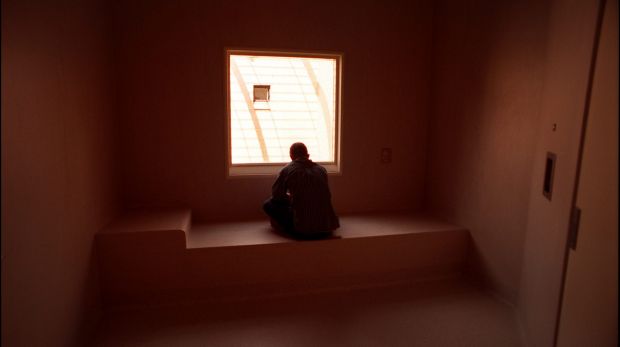
A patient in a seclusion room. Photo: Eamon Gallagher
The solitary confinement of mentally ill people is declining in Australia, a new report shows, but advocates say greater efforts are needed to eliminate the outdated technique.
Data to be released by the Australian Institute of Health and Welfare on Wednesday show a patient was confined by themselves in about one in 20 occasions in which people were admitted to public hospitals for mental health-related care in 2013-14. The average duration of a seclusion event was six hours.
Nationally, rates of seclusion have declined by an average of 12 per cent per year since 2008-09, when seclusion data was first collected.
Former NSW chief psychiatrist John Allan, who is now Queensland’s chief psychiatrist and the chairman of the Safety and Quality Partnership Standing Committee, said while the decline was “pleasing”, he would like to see the reduction in seclusion accelerated.
He said seclusion was “not really a treatment, but just a way of controlling behaviour” that could be “quite harmful to the patient”, leaving them feeling “lost and helpless”.
“It isn’t really therapeutic – it might change the person’s behaviour but it doesn’t make them feel better about themselves,” Associate Professor Allan said.
He said it was important to prevent people from becoming so unwell that seclusion was considered necessary.
Reducing or eliminating the use of seclusion has been a priority of Commonwealth, state and territory health ministers for almost a decade.
Despite this, the National Mental Health Commission says the issue is regularly raised with it by individuals and their families as well as service providers and policymakers.
In its national report card on mental health last year, the commission said seclusion was “not therapeutic and not in line with human rights”, and it expressed disappointment that the nation was so far from its target of ending the practice.
The commission plans to issue a position paper on seclusion early next year.
While it is sometimes considered necessary to protect patients and staff, seclusion can also cause distress and trauma.
The NSW Ministry of Health says seclusion, which involves locking patients in a room alone, should be used only as a last resort.
In Victoria, the Office of the Public Advocate had called on the state government to eliminate the use of seclusion in its mental health facilities.
Nationally, there were eight seclusion events in mental health facilities per 1000 bed days in 2013-14, down from 15.5 per 1000 bed days in 2008-09..
Children and adolescents had the highest rate of seclusion, at 9.6 seclusion events per 1000 bed days, with an average duration of 1.3 hours. Older people had the lowest rate – 0.5 seclusion events per 1000 bed days and an average seclusion duration of 3.5 hours.
Forensic services confined patients at a rate of 5.3 seclusion events per 1000 bed days. The average duration of a seclusion event in a forensic service was 64.7 hours.
In NSW, across all public mental health facilities, there were 7.4 seclusion events per 1000 bed days, and the average duration of seclusion was 6 hours. Seclusion occurred in 5.3 per cent of occasions in which a person was admitted to hospital for mental health-related care. Of those occasions that included a seclusion event, the average number of seclusion events was 1.8.
In Victoria, across all public mental health services, there were 9.2 seclusion events per 1000 bed days. The average duration of a seclusion event was 9.5 hours – the highest average duration of any Australian jurisdiction. A patient was confined in 6 per cent of occasions in which a person was admitted to hospital for mental health-related care in the state. Of those episodes that included a seclusion event, the average number of seclusion events was 2.3.
